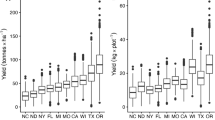Abstract
The generation of AFLPs in spring barley cultivars provided genetic information relating to the development of the crop in the UK since 1953. Principal co-ordinate (PCO) analysis of genetic similarities (gs) confirmed the marked contrast in the cultivars used in the 1970s and 1980s. The earliest cultivars, many derived from Proctor, were succeeded by tall-strawed, disease-resistant types with high yield but poor malting potential. In the 1980s they were in turn replaced by short-strawed cultivars with excellent yield and good malting quality, which originated from Triumph. A PCO plot of gs provided insight into the effects of selection for disease resistance and the antagonism between malting quality and particular resistance genes. The analysis of gs was more useful than pedigrees and estimates of kinship in revealing the genetic relationship between cultivars. Theoretical considerations for maximising the efficiency of an AFLP genotyping programme are discussed in the context of the number of primer pairs required to distinguish genotypes at varying levels of similarity.
Similar content being viewed by others
References
Anonymous: Catalogue of germplasm collections 1989. AFRC Institute of Plant Science Research and John Innes Institute, Norwich (1989).
Autrique E, Nachit MM, Monneveux P, Tanksley SD, Sorrels ME: Genetic diversity in durum wheat based on RFLPs, morphophysiological traits and coefficient of parentage. Crop Sci 36: 735–742 (1996).
Becker J, Vos P, Kuiper M, Salamini F, Heun M: Combined mapping of AFLP and RFLPmarkers in barley. Mol GenGenet 249: 65–73 (1995).
Bernardo R: Best linear unbiased prediction of maize singlecross performance. Crop Sci 36: 50–56 (1996).
Graner A, Ludwig WF, Melchinger AE: Relationships among European barley germplasm. 2. Comparison of RFLP and pedigree data. Crop Sci 34: 1199–1205 (1994).
Gothard PG, Riggs TJ, Smith DB: The malting quality of some spring barley varieties grown in England and Wales between 1880 and 1980. J Inst Brew 89: 344–348 (1983).
Horsley RD, Schwarz PB, Hammond JJ: Genetic diversity in malt quality of North American six-rowed spring barley. Crop Sci 35: 113–118 (1995).
Mackill DJ, Zhang Z, Redona ED, Colowit PM: Level of polymorphism and genetic mapping of AFLP markers in rice. Genome 39: 969–977 (1996).
Martin JM, Blake TK, Hockett EA: Diversity among North American spring barley cultivars based on coefficients of parentage. Crop Sci 31: 1131–1137 (1991).
Maughan PJ, Saghai-Maroof MA, Buss GR: Amplified fragment length polymorphism (AFLP) in soybean species diversity, inheritance, and near-isogenic line analysis. Theor Appl Genet 93: 392–401 (1996).
Melchinger AE, Graner A, Singh M, Messmer MM: Relationships between European barley germplasm. 1. Genetic diversity among winter and spring cultivars revealed byRFLPs. Crop Sci 34: 1191–1199 (1994).
Paterson AH, Lin Y-R, Li Z, Schertz KF, Doebley JF, Pinson SRM, Liu S-C, Stansel JW, Irvine JE: Convergent evolution of cereal crops by independent mutations at corresponding genetic loci. Science 269: 1714–1718 (1995).
Paul S, Wachira FN, Powell W, Waugh R: Diversity and genetic differentiation among populations of Indian and Kenyan tea (Camellia sinensis (L.) O. Kuntze) revealed by AFLP markers. Theor Appl Genet 94: 255–263 (1996).
Powell W, Morgante M, Vogel J, Tingey S, Rafalski AJ: Technology for plant genome analysis and breeding. Proc IPBG, Rogla (1994).
Powell W, Morgante M, Andre C, Hanafey M, Vogel J, Tingey S, Rafalski A: The comparison of RFLP, RAPD and SSR (microsatellite) markers for germplasm analysis. Mol Breed 2: 225–238 (1996).
Powell W, Thomas WTB, Baird E, Lawrence P, Booth A, Harrower B, McNicol JW, Waugh R: Analysis of quantitative traits in barley by use of amplified fragment length polymorphism. Heredity, in press.
Rafalski AJ, Vogel JM, Morgante M, Powell W, Andre C, Tingey SV: Generating and using DNA markers in plants. In: Non-Mammalian Genomic Analysis: A Practical Guide, pp. 75–134. Academic Press New York (1996).
Riggs TJ, Hanson PR, Start ND, Miles DM, Morgan CL, Ford MA: Comparison of spring barley grown in England and Wales between 1880 and 1980. J Agric Sci 97: 599–610 (1981).
Russell JR, Fuller JD, Macaulay M, Hatz BG, Jahoor A, Powell W, Waugh R: Direct comparison of levels of genetic variation among barley accessions detected by RFLPs, AFLPs, SSRs and RAPDs. Theor Appl Genet, in press.
Silvey V: The contribution of new wheat, barley and oat varieties to increasing yield in England and Wales 1947–78. J Natl Inst Agric Bot 15: 399–412 (1981).
Saghai-Maroof MA, Soliman KM, Jorgensen RA, Allard RW: Ribosomal DNA spacer-length polymorphism in barley: Mendelian inheritance, chromosomal location and population genetics. Proc Natl Acad Sci USA 81: 8014–8018 (1984).
Swanston JS: The consequences, for malting quality, of Hordeum laevigatum as a source ofmildew resistance in barley breeding. Ann Appl Biol 110: 351–355 (1987).
Thomas WTB, Powell W, Swanston JS, Ellis RP, Chalmers KJ, Barua UM, Jack P, Lea V, Forster BP, Waugh R, Smith DB: Quantitative trait loci for germination and malting quality characters in a spring barley cross. Crop Sci 361: 265–273 (1996).
Thomas WTB, Powell W, Waugh R, Chalmers KJ, Barua UM, Jack P, Lea V, Forster BP, Swanston JS, Ellis RP, Hanson PR, Lance RCM: Detection of quantitative trait loci for agronomic, yield, grain and disease characters in spring barley (Hordeum vulgare L.). Theor Appl Genet 91: 1037–1047 (1996).
Tinker NA, Mather DE: KIN: software for computing kinship coefficients. J Hered 84: 238 (1993).
Travis SE, Maschinski J, Keim P: An analysis of genetic variation in Astragalus cremnophylax var. cremnophylax, a critically endangered plant, using AFLP markers. Mol Ecol 5: 735–745 (1996).
Vos P, Hogers R, Bleeker M, Reijans M, van de Lee T, Hornes M, Frijters A, Pot J, Peleman M, Kuiper M, Zabeau M: AFLP: a new technique for DNA fingerprinting. Nucl Acids Res 23: 4407–4414 (1995).
Zabeau M, Vos P: Selective restriction fragment amplification: a general method for DNA fingerprinting. European Patent Application number 92402629.7. Publication number 0 534 858 A1 (1993).
Author information
Authors and Affiliations
Rights and permissions
About this article
Cite this article
Ellis, R.P., McNicol, J.W., Baird, E. et al. The use of AFLPs to examine genetic relatedness in barley. Molecular Breeding 3, 359–369 (1997). https://doi.org/10.1023/A:1009602321815
Issue Date:
DOI: https://doi.org/10.1023/A:1009602321815




